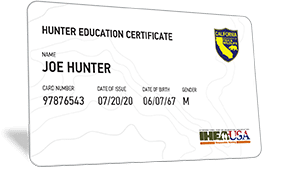
AGE REQUIREMENTS FOR CALIFORNIA HUNTERS
All first-time hunters in the state of California are required to obtain hunter education certification in order to purchase a hunting license within the state. Additionally, hunter education is required for non-resident hunters who do not possess or have proof of a hunting license issued by another state or province within the last two years.

CALIFORNIA HUNTING EDUCATION REQUIREMENTS
WHAT IS A CALIFORNIA HUNTER EDUCATION CERTIFICATE
A California Hunter Education Certificate proves that you’ve obtained the knowledge needed to hunt safely, responsibly, and ethically, within the state of California. All hunters, first-time hunters in California are required to get certified in order to purchase a hunting license.
WHERE CAN I GET MY CALIFORNIA HUNTER EDUCATION CERTIFICATE?
You can obtain your California Hunter Education Certificate by completing a California Department Fish and Wildlife -approved course. Courses can be taken either partially online with a follow-up class or in-person, depending on your preference.
Traditional Classroom Course Option
Hunters may choose to obtain hunter education certification by completing a traditional instructor-led classroom course. Classroom courses take a minimum of 10 hours to complete and may take place in a single session or over a period of multiple days.
Online + Follow-up Course:
Hunters may also choose to complete their hunter education certification by completing an online course in combination with a follow-up course. The online portion of the course typically take 4-6 hours to complete. Once the online portion is successfully completed, the student may register for and complete a 4-hour follow-up course. Upon the completion of both portions, the student will be issued their hunter education certification.
HOW OLD DO I HAVE TO BE TO GET A HUNTER EDUCATION CERTIFICATE IN CALIFORNIA?
There is no minimum age to complete a hunter education course in California, and obtain a Hunter Education Certificate.
Is my California Hunter Education Certificate valid in other states?
The California Hunter Education Certificate will be accepted in any US state, province, or country which also requires mandatory hunter education, meaning hunters who have obtained their California Hunter Education Certificate may use it to hunt in other states. This is known as “reciprocity”.
What's the difference between a Hunter Education Certificate and a Hunting License?
A Hunter Education Certificate proves that you’ve obtained the knowledge you need to hunt safely and ethically in California, and is different from a Hunting License. The Hunting Licence is similar to a permit, and is required to hunt any game animal within the state. Different licenses and permits may be required depending on which game animal is being hunted.
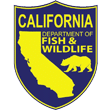
HUNTING LICENSES, STAMPS, AND PERMITS
HUNTING LICENSES
A Hunting License is required in the state of California to hunt any game animal. There are a variety of license types available depending on your age, residency status, and what type of game you plan to hunt. Some of the hunting license types in California include:
Resident Hunting License
This license type is required for all California residents to legally hunt within the state of California and is issued to residents who are 16 years of age or older. Additional license types, permits, and tags may be required in order to take certain game animals or hunt within a particular area.
Junior Hunting License
Junior hunting licenses are issued to California residents who are less than 16 years of age and permits to take game birds and mammals within the state. The holder must be less than 16 years of age at the beginning of the hunting year (July 1st) to obtain the license.
Non-resident Hunting License
Non-resident hunting licenses are available to those who do not reside within the state of California but wish to take game within the state. Non-residents may choose to obtain annual licenses, 1-day, or 2-day license types.
CALIFORNIA HUNTER CERTIFICATION AGE REQUIREMENTS

UNDER 12 YEARS OF AGE
Hunters who are less than 12 years of age are not permitted to purchase a deer tag within the state of California, regardless of whether they have obtained a Hunter Education Certificate.

First-time Hunters
All first-time hunters, regardless of age, are required to obtain hunter education certification in order to purchase a hunting license within the state of California.
CALIFORNIA HUNTING FAQS
DO I NEED A HUNTING LICENSE TO HUNT WITHIN THE STATE OF CALIFORNIA?
Yes. A Hunting License is different from a Hunter Education Certificate and is required for any person who hunts any game animal within the state. This includes both residents and non-residents. Varying licenses must be purchased and carried depending on the hunter’s age, residency, and the type of game being hunted. Certain exceptions may apply depending on the game animal being hunted. For more information on California, hunting licenses visit the California Department of Fish and Wildlife Licenses and Tag page.
WHAT ARE THE CALIFORNIA TAGGING REQUIREMENTS?
Certain game animals must be tagged after they’re taken, including big game animals such as deer, bear, and elk. It’s important for hunters to understand the tagging and/or harvest reporting requirements for the game animal they’re hunting, and to ensure that the animal is tagged and reported properly.
Tagging and Reporting Requirements
To hunt big game species such as deer and bear, the hunter must purchase a license and tag. Upon successfully harvesting big game species within the state, the hunter must immediately fill out all portions of the tag including the harvest report card. The following information must be complete:
- Effort-related questions
- Date and month of harvest (by cutting out or punching appropriate portions of the tag)
If the game animal has antlers, the antler portion of the license tag must then be securely attached to the antlers of the carcass.
Deer and elk tags must also be countersigned prior to the game animal being transported – except to take the animals to the nearest person or estate-agent who may countersign the license tag.
Mandatory Harvest Reporting for Deer Tag Holders
Harvest reports must be submitted by all deer tag holders who successfully take a deer within the state of California. The hunter must submit a completed report within 30 days of taking a deer. If the hunter is not successful, they must submit a completed report, and answer applicable questions, and submit the report by January 31st.
Reports can be submitted either online or by mail, by visiting the California Department of Fish and Wildlife website, or by mailing the completed report to the CDFW Branch at PO Box 944209, Sacramento, Ca, 94299
WHAT ARE THE HUNTER ORANGE REQUIREMENTS IN CALIFORNIA?
While there are no mandatory hunter orange requirements for hunters within the state of California, upland game hunters are strongly encouraged to wear hunter orange while hunting.
WHAT ARE THE BAG LIMITS IN CALIFORNIA?
Bag limits are imposed on hunters to restrict the number of a particular game animal that can be taken. Bag limits may be daily or seasonal depending on the type of animal. Daily bag limits may be imposed which restrict the number of a particular game animal that may be taken within one hunting day, whereas seasonal bag limits restrict the number of a particular game animal that may be taken by a hunter within the hunting season.
For more information on bag limits in the state of California, visit the California Department of Fish and Wildlife website.

GAME AND NON-GAME SPECIES
GAME SPECIES
California offers a wide variety of game species for all types of hunters. The states mountainous landscape and rolling hills and valleys result in a wide range of habitats and ecosystems for wildlife, including game species.
Game species in California include:
- Big game including deer, black bear, elk, pronghorn, and turkey.
- Small and upland game including pheasant, ruffed grouse and quail.
- Waterfowl and other migratory game birds including ducks, geese, coots, and dove.
- Small mammals including squirrels, rabbits, and jackrabbits.
NON-GAME SPECIES
Nongame species within the state of California make up a majority of the state’s wildlife and include mammals, birds, fish, reptiles, amphibians, and invertebrates which typically may not be hunted, are considered a nuisance, or are protected, endangered, or at risk. There is, unfortunately, a lengthy list of endangered, protected, and threatened species within the state. For more information on nongame, and endangered species within the state visit the California Department of Parks and Wildlife website.
INVASIVE SPECIES
Invasive animals and other pests have been introduced to the United States, including the State or California, and have become a threat to native wildlife. These animals, plants, fish, and invertebrates typically have no natural predators which can result in rapid spread and population growth. This in turn can seriously harm the state’s lands and waters, and can be detrimental to the health and population numbers of a variety of the state’s native plants and animals. Some common invasive species in California include nutria, mute swan, northern watersnake, and chinese mitten crab, among others.
In order to protect California’s native plants and animals, invasive species must be controlled and eradicated. Anyone who encounters or suspects that they have encountered an invasive species within the state is encouraged to report the sighting so that it can be monitored and controlled. For information on how to report various types of invasive species in California visit the California Department of Parks and Wildlife Invasive Species Program page.

CALIFORNIA HUNTING SEASONS
Hunting seasons and dates may change annually per game animal, depending on a variety of factors. Season dates are further broken out, region or zone. Additionally, seasons are often categorized by firearm time, including archery, firearms, and muzzleloader or “primitive” firearms seasons.
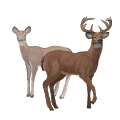
Deer
Deer seasons in California are organized by take method, and hunting zone, and include a general season and archery seasons. Deer season typically opens in August and closes in November however, dates vary significantly based on the region being hunted, and designated archery zones.

Bear
Bear seasons in California are organized by firearm type, and within hunting zones and regions across the state. The bear seasons open concurrently with the general deer season each year, for most zones, while the remainder of the zones will see the season open in early October. The season typically closes in late December.
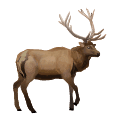
Elk
Elk seasons dates are organized by various regions within the state, and tag allocations are limited. The season typically opens as early as August in some regions, and closes as late as January of the following calendar year for later seasons.

Small Game
There are several small game animals to hunt in the State including squirrels, ruffed grouse, rabbits, pheasant, bobwhite quail, hare, groundhogs, crows, starlings and sparrows. Seasons dates for small game types vary depending on the game animal type. Most seasons begin in October and continue until January or February, although squirrel season begins in September.
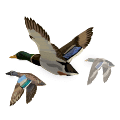
Ducks
Duck seasons are organized by zone and seasons dates may vary depending on the zone being hunted. Duck season typically opens in early October and closes in January of the following year.
HUNTING ON PUBLIC OR PRIVATE LAND
PRIVATE LAND
Much of the land in California is privately owned. Hunters can typically freely take game animals hunted on their own private property or may seek permission from a landowner to hunt on private property. Hunters who wish to take game on privately owned land must follow state hunting regulations as well as any regulations specified by the landowner. Hunters must ensure they respect the rights and property of the landowner at all times.
PUBLIC LAND
More than 1 million acres of public lands, across more than 700 properties, are managed by the California Department of Parks and Wildlife. These lands are designated for wildlife and habitat management, and conservation, and are open to a variety of recreational outdoor activities, including hunting.
State-managed lands within California encompass a wide variety of landscapes, habitats, and ecosystems and are home to a vast number of game species. Public lands may also have special rules and regulations in place that must be followed by all land users.
For more information on the rules and regulations that apply to hunters and other recreational users of state lands, visit the California Department of Parks and Wildlife.
WILDLIFE AREAS
California Wildlife Areas
The California Department of Fish and Wildlife manages more than 700 properties, which encompass over 1 million acres of land throughout the state, including Wildlife Areas, and Ecological Reserves. These properties provide expansive habitats and diverse wildlife populations including plant species, fish, and game species.
Wildlife Area Regulations
Wildlife Areas are open to public use and permit a wide variety of outdoor recreational activities including hiking, wildlife watching, fishing and hunting. Additional regulations may apply within these properties which apply to all users. Regulations may vary depending on the property and the type of activity. Some of these regulations may include:
- Camping restrictions
- Vehicle use restrictions
- Firearms restrictions
- Additional bag limits restrictions
- Game species restrictions
- Boat use restrictions
The Golden State. Ready and rarin’ to go.

Where to Hunt in California
The state of California has an incredibly diverse landscape. It’s mountain ranges, lush forests, swamplands and deserts result in a wide variety of habitats and expansive wildlife populations, including a plethora of game species. Whether you’re in search of big game, birds, or exotic species, you’re guaranteed to find a hunting opportunity that suits your interests.
Deer and bear are particularly popular game animals in the state and there are no shortages of hunting opportunities for either species. Black bear populations in particular have continued to grow over the last few decades and include two sub-species – the Northwestern Black Bear and the California Black Bear. Populations are especially dense along the state’s north coast, including in the Klamath National Forest and the Marble Mountain Wilderness Area.
Deer hunters will find success in a variety of regions, and populations are healthy across the state. For top spots, check out the Cache Creek Wilderness Area, Jackson State Forest, and Mendocino National Forest.
Duck and waterfowl hunting is another top hunting opportunity across the state. Waterfowl populations across the state are abundant, particular in grassland areas within the central region of the state. Popular public hunting areas for waterfowl include the San Luis National Wildlife Refuge, and China Island Wildlife Refuge.
